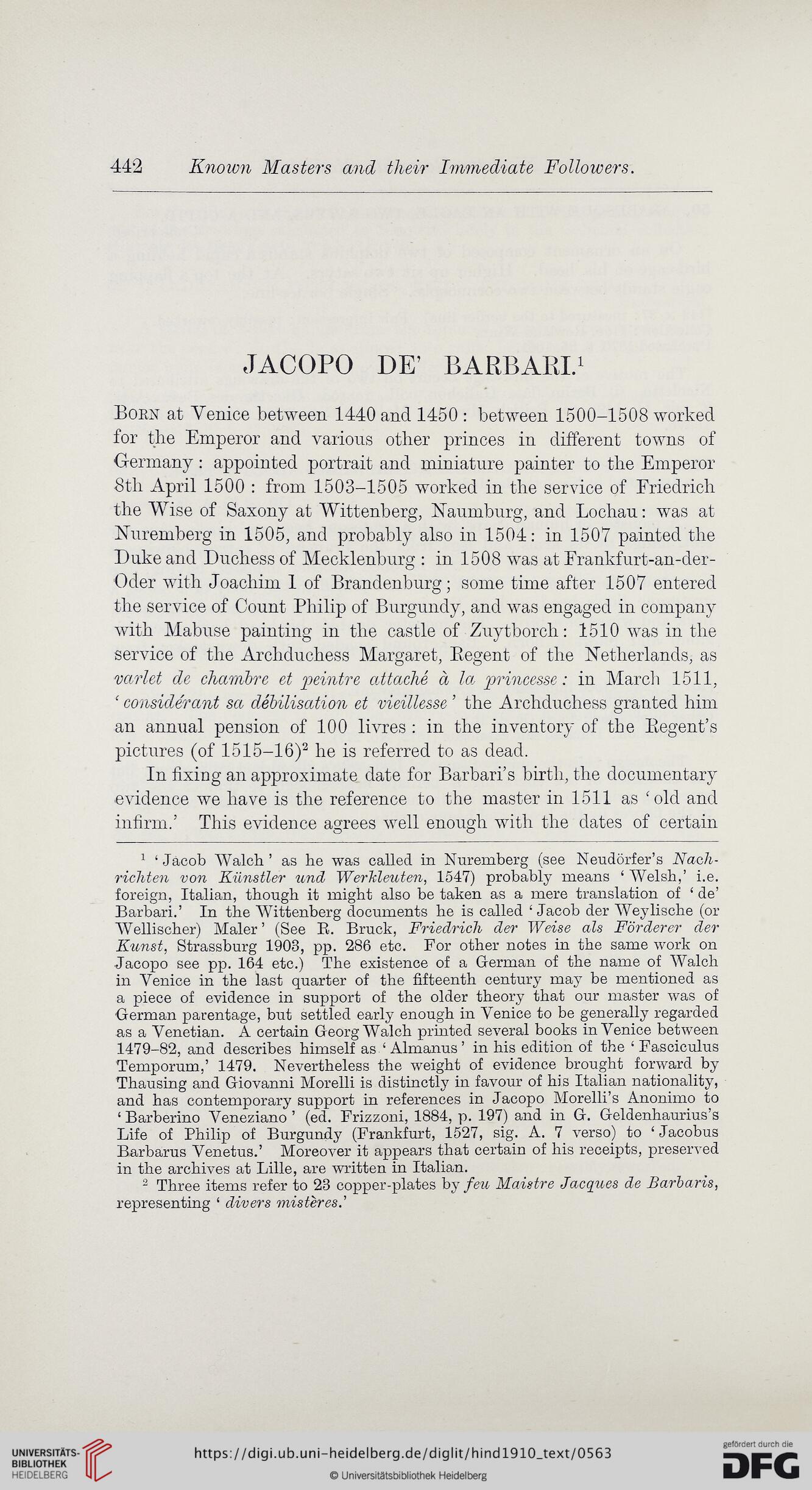442
Known Masters and their Immediate Followers.
JACOPO DE’ BARBARI.1
Born at Venice between 1440 and 1450 : between 1500-1508 worked
for the Emperor and various other princes in different towns of
Germany: appointed portrait and miniature painter to the Emperor
8th April 1500 : from 1503-1505 worked in the service of Friedrich
the Wise of Saxony at Wittenberg, Naumburg, and Lochau: was at
Nuremberg in 1505, and probably also in 1504: in 1507 painted the
Duke and Duchess of Mecklenburg : in 1508 was at Frankfurt-an-der-
Oder with Joachim 1 of Brandenburg; some time after 1507 entered
the service of Count Philip of Burgundy, and was engaged in company
with Mabuse painting in the castle of Zuytborch: 1510 was in the
service of the Archduchess Margaret, Regent of the Netherlands, as
varlet de chamibre et peintre attache a la prineesse: in March 1511,
‘ considerant sa debilisation et vieillesse ’ the Archduchess granted him
an annual pension of 100 livres : in the inventory of the Regent’s
pictures (of 1515-16)2 he is referred to as dead.
In fixing an approximate date for Barbari’s birth, the documentary
evidence we have is the reference to the master in 1511 as "old and
infirm.’ This evidence agrees well enough with the dates of certain
1 ‘ Jacob Watch ’ as he was called in Nuremberg (see Neudorfer’s Nach-
richten von Kunstler und Werkleuten, 1547) probably means ‘ Welsh,’ i.e.
foreign, Italian, though it might also be taken as a mere translation of ‘ de’
Barbari.’ In the Wittenberg documents he is called ‘Jacob der Weylische (or
Wellischer) Maier ’ (See R. Bruck, Friedrich der Weise als Forderer der
Kunst, Strassburg 1903, pp. 286 etc. For other notes in the same work on
Jacopo see pp. 164 etc.) The existence of a German of the name of Walch
in Venice in the last quarter of the fifteenth century may be mentioned as
a piece of evidence in support of the older theory that our master was of
German parentage, but settled early enough in Venice to be generally regarded
as a Venetian. A certain Georg Walch printed several books in Venice between
1479-82, and describes himself as ‘ Almanus’ in his edition of the ‘ Fasciculus
Temporum,’ 1479. Nevertheless the weight of evidence brought forward by
Thausing and Giovanni Morelli is distinctly in favour of his Italian nationality,
and has contemporary support in references in Jacopo Morelli’s Anonimo to
‘ Barberino Veneziano ’ (ed. Frizzoni, 1884, p. 197) and in G. Geldenhaurius’s
Life of Philip of Burgundy (Frankfurt, 1527, sig. A. 7 verso) to ‘Jacobus
Barbarus Venetus.’ Moreover it appears that certain of his receipts, preserved
in the archives at Lille, are written in Italian.
2 Three items refer to 23 copper-plates by feu Maistre Jacques de Barbaris,
representing ‘ divers misteres.’
Known Masters and their Immediate Followers.
JACOPO DE’ BARBARI.1
Born at Venice between 1440 and 1450 : between 1500-1508 worked
for the Emperor and various other princes in different towns of
Germany: appointed portrait and miniature painter to the Emperor
8th April 1500 : from 1503-1505 worked in the service of Friedrich
the Wise of Saxony at Wittenberg, Naumburg, and Lochau: was at
Nuremberg in 1505, and probably also in 1504: in 1507 painted the
Duke and Duchess of Mecklenburg : in 1508 was at Frankfurt-an-der-
Oder with Joachim 1 of Brandenburg; some time after 1507 entered
the service of Count Philip of Burgundy, and was engaged in company
with Mabuse painting in the castle of Zuytborch: 1510 was in the
service of the Archduchess Margaret, Regent of the Netherlands, as
varlet de chamibre et peintre attache a la prineesse: in March 1511,
‘ considerant sa debilisation et vieillesse ’ the Archduchess granted him
an annual pension of 100 livres : in the inventory of the Regent’s
pictures (of 1515-16)2 he is referred to as dead.
In fixing an approximate date for Barbari’s birth, the documentary
evidence we have is the reference to the master in 1511 as "old and
infirm.’ This evidence agrees well enough with the dates of certain
1 ‘ Jacob Watch ’ as he was called in Nuremberg (see Neudorfer’s Nach-
richten von Kunstler und Werkleuten, 1547) probably means ‘ Welsh,’ i.e.
foreign, Italian, though it might also be taken as a mere translation of ‘ de’
Barbari.’ In the Wittenberg documents he is called ‘Jacob der Weylische (or
Wellischer) Maier ’ (See R. Bruck, Friedrich der Weise als Forderer der
Kunst, Strassburg 1903, pp. 286 etc. For other notes in the same work on
Jacopo see pp. 164 etc.) The existence of a German of the name of Walch
in Venice in the last quarter of the fifteenth century may be mentioned as
a piece of evidence in support of the older theory that our master was of
German parentage, but settled early enough in Venice to be generally regarded
as a Venetian. A certain Georg Walch printed several books in Venice between
1479-82, and describes himself as ‘ Almanus’ in his edition of the ‘ Fasciculus
Temporum,’ 1479. Nevertheless the weight of evidence brought forward by
Thausing and Giovanni Morelli is distinctly in favour of his Italian nationality,
and has contemporary support in references in Jacopo Morelli’s Anonimo to
‘ Barberino Veneziano ’ (ed. Frizzoni, 1884, p. 197) and in G. Geldenhaurius’s
Life of Philip of Burgundy (Frankfurt, 1527, sig. A. 7 verso) to ‘Jacobus
Barbarus Venetus.’ Moreover it appears that certain of his receipts, preserved
in the archives at Lille, are written in Italian.
2 Three items refer to 23 copper-plates by feu Maistre Jacques de Barbaris,
representing ‘ divers misteres.’




